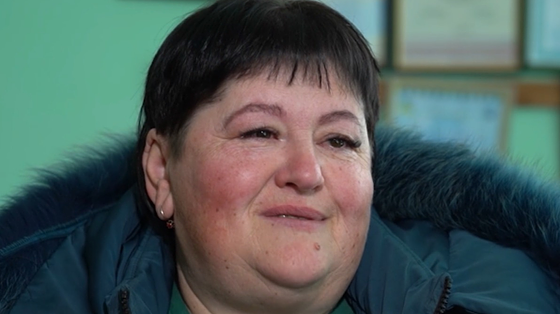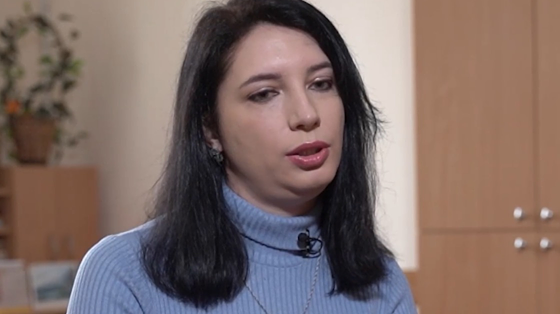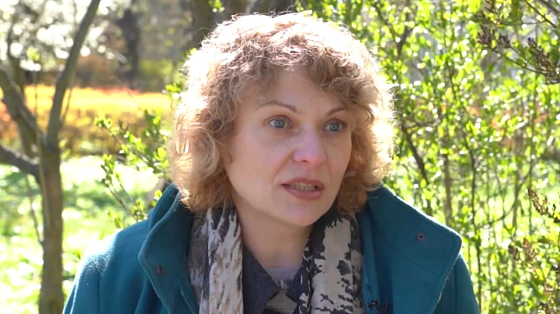Serhiy Layevskyi is the director of the Chernihiv Regional Historical Museum. From the beginning of the russian invasion, the museum’s staff started a large-scale work on saving the exhibits. For more than a month, research officers packed the most valuable items and strengthened the building. In April 2022, journalists from TV channel Kyiv recorded an interview with Serhiy Layevskyi about how history was saved under shelling.
Like for everyone else, for us the war obviously began on 24 February with the morning bombings, including those in Chernihiv region. To an extent, we were preparing ourselves for this internally, as we were working through some questions related to the evacuation of museum exhibits. Or rather, their relocation to a more reliable storage. Since we had not managed to evacuate anything, on 24 February, we started our working day. We were busy with dismantling and removing some museum items of special value, with packing them, and moving them to some more reliable places. Subsequently, during the entire siege of Chernihiv, which continued (from the end of February, through March and until the beginning of April), six members of the museum staff, who remained in this building 24/7, were busy with dismantling those museum objects that remained in the collection of its exhibits. We intended to relocate them to those places that were more reliable, in our opinion.
We traced where the shells, mines, and Grad MLRS rockets were coming from, where the enemy bombs were falling, and picked the places that were most protected from the point of view of keeping the museum items safe.
During the first week, the museum staff went back home, but when two of our staff members had their housing damaged, they moved over to the museum, and there were six of us here. Our fear vanished in about ten days, and it’s obvious that this was rather individual. Each person experiences his or her fear, perhaps in an individual, special way. I had such a day when I felt really scared. My fear came to me and I met it, I faced it. It looked like…, you know, when your hands just freeze here and you don’t feel them, just wild cold.
I realized that this was exactly it, that fear. I asked myself a question, “Why is it the way it is?” And I recalled. Once when I was a child and when I did not want to go to bed, my dad said, “If you don’t go to sleep, the Snow Queen will come to you. She is so icy and brings such coldness.”
So apparently, she came to me. But that was only once, and it did not happen again after that. My body knew where that fear could hide and simply blocked its entire path. This wall was one of the most dangerous in a certain phase of the hostilities, and the artillery strike hit exactly there, right into it. We collected the most valuable items from here. The museum building remained almost intact, with some minor damage caused by fragments of a mine that exploded near our colleagues from the Art Museum. They suffered a little more than we did. We had many broken windows, and we collected several fragments of this mine from our position. Fortunately, as I mentioned earlier, no one was injured then.
Back in 2014-2015, we started, and then, in 2018, we returned to questions of saving our valuable museum items (valuable assets). We worked out an algorithm foreseeing the engagement of staff in all these actions. However, I, being a director, clearly understood that the majority of our staff might be unable to come to work, as they would be busy with evacuating their near and dear ones. Many of them have children, and many have elderly parents too. Our staff members, quite a number of them, are of rather a respectable age. This is not meant to say that I was surprised. Somewhere inside me, I rather had no doubts that people would come.
On 24 February, almost 90% of our staff members came to work, that is why we managed to do a lot on those particular days. I suppose I am lucky that my children and my grandchildren had long been outside Chernihiv. They don’t even live in Ukraine. I have my 86-year-old mother and my sister in Chernihiv. I cannot say they were in safety, but they were together, so...
My wife works in the museum. I live next to the museum, so I had no other thoughts than to go and save the museum’s valuable assets.
Especially as I had all the opportunities for it. In fact, our staff members, who remained here, acted in the same way, making the protection of the museum’s items a priority. Yes, their relatives were here in Chernihiv, but every day, they called in, they got in touch by phone, when the telephone connection still remained reliable or when at least some telephone signal was available. And that is why, choosing between their own rescue and saving of the museum’s exhibits, they in fact combined two in one: saving themselves here and saving the museum assets. In fact, there are five pre-Mongol churches in Chernihiv. That is, those that were built before 1240. These churches have been preserved above ground, and this is the largest concentration of such structures in Central and Eastern Europe. Not all of them had survived the Second World War, as several of them had to be rebuilt. They much better survived the hot phase of the current Russian-Ukrainian war, when Chernihiv was under siege. They have some minor damages from fragments of various projectiles and mines, which flew here through our city during shelling. Well, in particular, the Cathedral of the Transfiguration of the Saviour on the Chernihiv Detinets (stronghold).
This is the oldest structure, which began to be built back in the 1030s, that is, soon it will be almost a thousand years since the time it was built. On or around the last days of shelling in our city, a cluster projectile hit nearby, and several of the cartridges that flew out of it exploded, showering the walls of this cathedral with fragments. It is clear that these damages are very small, but the very fact that it was a shot in the direction of the church, which is part of the Moscow Patriarchate, probably sends a certain signal.
Speaking in general, Chernihiv has many historical and architectural landmarks, and unfortunately, not all of them survived the siege of Chernihiv so successfully, to put it mildly.
The building of the Vasyl Tarnovskyi Museum of Antiquities, which houses the youth library and which is extremely interesting in terms of its history and architecture, received significant damage. In fact, this building is half-ruined now. The building of the Noble and Peasant Land Bank, which houses Korolenko Regional Universal Library, was damaged too. There is just a big hole in the roof and one of the corners was damaged. This is a building of the early 20th century. The building of Shchors Cinema, which is its former name, was damaged again.
This building had been built sometime in the late 1930s. During the Second World War, a German bomb hit the middle of this building, completely destroying everything except the central facade. At the beginning of March, a russian missile hit there, which hit exactly at that point and destroyed almost everything. The interior is very badly damaged, but the exterior facade has survived. What is interesting... If to think a little ahead, about the future perspective, that cinema was rebuilt right at the end of the 40s, and it was there where the trial of war criminals took place.
Those were Hungarian soldiers and officers who committed atrocities on the territory of Chernihiv region. I could be wrong, but I really want the trial of the russian war criminals, who committed their atrocities in Chernihiv region, to take place in that premise as well. This would be a lesson that would obviously be remembered forever.







.png)



